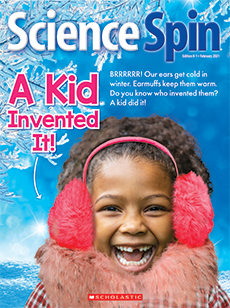September 2024
Raccoon Science
Academic Standards
Reading Objective:
Students will identify steps scientists use to conduct investigations as they read about a raccoon scientist’s experiment.
Next Generation Science Standards:
Practice 3: Planning and Carrying Out Investigations
K-LS1: Animals’ survival needs
1-LS1: The survival needs of plants and animals
Vocabulary:
test, observe, record, loner, social
Use your Science Spin to find the best answer to each question.
1. What question did Lauren ask about raccoons?
(Do they work alone?)
2. How did Lauren try to find the answer to her question?
(She set up a test with a night camera and food for raccoons)
3. What did Lauren see on the videos?
(The raccoons came in groups to steal the food.)
4. Draw what Lauren saw when she observed the raccoons.
(Answers will vary.)
Go online to print or project the Reading Checkpoint.
- Raccoons are supersmart mammals that can solve some of the trickiest puzzles.
- A raccoon’s sense of touch is its superpower—letting it know what anything is, even in the dark.
resident Calvin Coolidge kept a raccoon named Rebecca in the White House. (A bad idea—wild animals can be dangerous.)
Materials: Pencils, clipboards, copies of the skill sheet. (Optional: hand lenses)
Overview: Like Lauren, students will observe an animal and record what it does. Skip the night cameras and head outside to find one. (Alternate: Observe a tree or other item in nature, or use photos/videos indoors.)
Directions:
- Before you leave the classroom, tell students they’ll go outside to be animal scientists like Lauren. Remind kids that she observes animals to learn about them.
- Give each student a clipboard, a pencil, and a copy of the skill sheet. Head outside.
- Ask kids what animals they see or might see. Remind them that if they’re quiet, they can observe more. Do they see or hear any birds or insects? At first, just let them explore and soak up impressions.
- When students spot an animal, remind them to observe quietly without touching.
- How does the animal move? Does it make a sound? Does it have legs, and if so, how many?
- Record observations on the skill sheets. If there’s time, students can share them with others—real scientists do that too!
